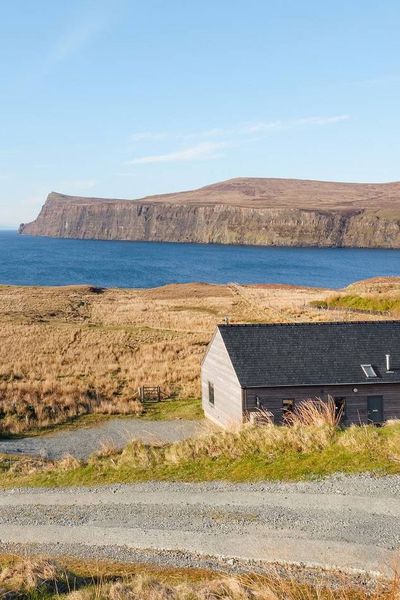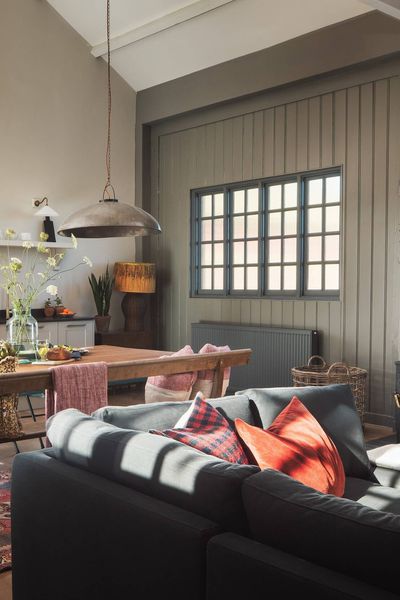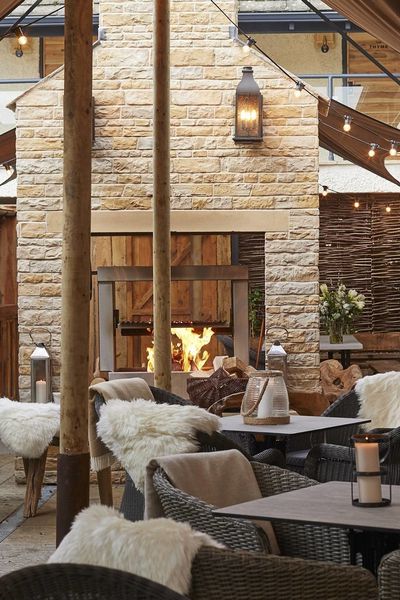
Brucefield: All of Scotland in one place
Sawday's Expert
5 min read
The Brucefield estate, an hour’s drive from Edinburgh, packs an incredible amount of Scottish wildlife and history into its relatively modest acreage and an equally impressive amount of style into Slackbrae, the self-catering cottage on site. I visited with my wife and 18-month old son, heading up one morning to meet owner Victoria Bruce-Winkler and talk to her about history, design and snacking on pigeons.
The long lane to Brucefield dips down through woodland before climbing to a hilltop, that looks out over the 1000 acres of the estate. As we slow to cross a bridge over a stream, a red squirrel hops up onto a fallen tree and poses briefly, a testimony to the health of the land as spring approaches.
We’re greeted by owner Victoria, outside a square of weathered stone buildings, topped by a dovecote, which is undergoing restoration. The plan is to walk down to Slackbrae, the self-catering cottage on one edge of the property but, as I’m about to discover, no plan lasts long at Brucefield. There’s simply too much to be distracted by. Victoria briefly mentions how the dovecote functioned as a living larder. “You just reached up and you know, grabbed lunch, which you’d eat entirely in one meal, so no need to cure or preserve the meat.” We’re still talking about “snack pigeons” when Graham, their Land Officer, wanders over.
Within seconds, he’s explaining the history of a stone set into the outer wall of the quadrangle, a 16th-century armorial that shows the coat of arms of the Stewarts of Rosyth and is one of only two pieces that remain of a mysterious structure called Hartshaw Tower, known to have been located somewhere on the property. This in turn leads to a potted history of the estate, which was “rebranded” by the Bruces when they took it over from the Stewarts. After a brief discussion of St/Queen Margaret of Scotland (she from the 11th century depicted on the armorial), 300 year-old lime trees, grand avenues that disappeared under Capability Brown’s naturalistic influence and the complexities of land management, we’re almost ready to begin. Then I chat for a while with Dawid Nowak, who delights in his role looking after guests and organising all the excursions and activities during their stay. Now we’re ready to begin.
While Victoria and I head for Slackbrae, my wife loads the baby into the backpack and heads off with Graham for one of the guided woodland walks that guests can enjoy. She’ll come back with tales of tree vertebrae, horse hoof fungi and the year’s first snowdrops, plus an urban myth of sunken tanks that were tested, unsuccessfully, in the muddy fields in wartime. She’ll also report how Graham himself came to do some work as a tree surgeon years ago and simply never left. As we pass through the dappled light of the towering pine trees, with the hillsides sloping into each other in the distance, I start to see how that’s entirely possible.


As we walk, Victoria goes into detail about the underlying mission of Brucefield and the huge amount of work that goes into achieving it. Extensive landscape, building and ecological (Phase 1 and 2) surveys undertaken over the last decade provide data and historical background on every building and almost every creature present on the land. A third of the 1000 acres, criss-crossed with beautiful walking trails, is Scots Pine and birch woodlands, “matching the splendour of the Caledonian Forest found in the Cairngorms National Park” according to independent ecologist Chris Cathrine who spearheads a 10-year wildlife plan for the estate. With a mosaic of different habitats including wet woodlands, heathery heath and meadows, the estate houses many creatures of conservation importance, including pine marten, red squirrel, birds (green woodpecker, lapwing, woodcock, tree sparrow), reptiles, barn owls and bat species. All this is especially remarkable given its proximity to Edinburgh or Glasgow. Victoria sees her job as keeping it all alive and bringing it together for guests, at which point we arrive, physically and conceptually, at Slackbrae.
The cottage is a masterpiece of design and ecological building that fuses history, craft, wildlife and the local community into the embodiment of the Brucefield vision and makes you realise that what really makes a great place to stay, is the care that goes into every detail, from the wood on the countertop to the food in the welcome hamper, the upholstery, even the tiles on the bathroom wall. In the beautiful space, styled with a nod to Victoria’s years working in Copenhagen, many guests have found inspiration for their own homes and gardens.


While some have picked up Clackmannanshire wallpaper and others have asked for the the wood burner details, it’s unlikely that any of them have been able to replicate the wildlife experiences. One group of guests were invited to see a goshawk being released into the woodlands by the SSPCA, others saw young pine martens tumbling in and out of the tree by the kitchen window. Moments like those can’t be planned of course, but some, such as the bat walks, most certainly can.
These night hikes through the woods with bat detectors, in the company of a local guide, often take guests by surprise, when the small devices are switched on and burst into life, revealing the busy truth behind the darkness of the forest. Day walks around the estate, keeping a lookout for deer, are much more sedate but no less interesting. You can stroll up to the witch’s stone and learn the local legend, trundle along the old railway line traffic-free Sustrans route (the estate hires out bicycles) that runs right past the garden, or drive 10 minutes to Dollar with its glen walks or the 16th century conservation village of Culross, both with inns and cafes. and yet more Scottish history written on every stone.


We leave Slackbrae after a quick stop in the herb garden outside the kitchen’s sliding doors. My head is full of warring clans, imagined bat squeaks and an aching desire to renovate our flat. Victoria tells me how one couple who visited from Kent told her that, after their stay, they felt they had “done Scotland”. I know what they meant, but I have to disagree. I feel like I could sit for a full turn of the seasons, exploring Brucefield’s storied wildness in sun and snow, but only just scratch the surface. Scottish History might be as old as time, but at Brucefield, that history is still alive, and still being written.
Explore all of our special places to stay in Scotland >
Want more travel inspiration? Get our email updates direct to your inbox.
Sign up >Share this article:
You might also like
Why I do it: Rachel Bucknall, owner of The Bridge Inn, The Ship and The Crusoe

Christopher Wilson-Elmes
Sawday's Expert
5 min read
Our guide to Scotland’s must-see regions

Jem Brownlee
Sawday's Expert
5 min read
Sustainability & soda – the remote Scottish distillery shaking up the whisky industry

Christopher Wilson-Elmes
Sawday's Expert
5 min read












